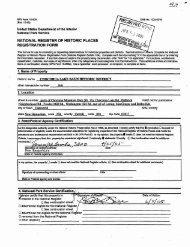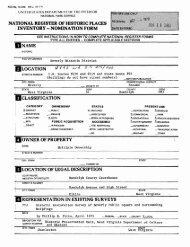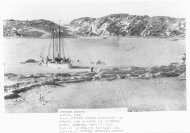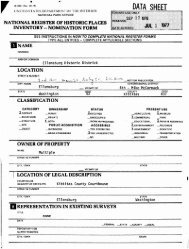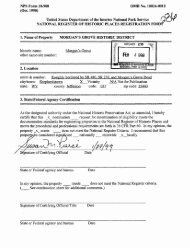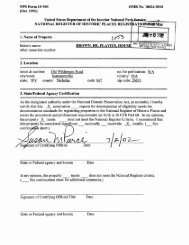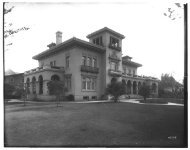National Register of Historic Places Registration Form
National Register of Historic Places Registration Form
National Register of Historic Places Registration Form
Create successful ePaper yourself
Turn your PDF publications into a flip-book with our unique Google optimized e-Paper software.
NFS <strong>Form</strong> 10-900-a 0MB Approval No. 1024-0018<br />
(MO)<br />
United States Department <strong>of</strong> the Interior<br />
<strong>National</strong> Park Service<br />
<strong>National</strong> <strong>Register</strong> <strong>of</strong> <strong>Historic</strong> <strong>Places</strong><br />
Continuation Sheet<br />
CLEVELAND PARK HISTORIC DISTRICT<br />
WASHINGTON D.C.<br />
Section number 8 Page _9_____<br />
1. The Cleveland Park <strong>Historic</strong> District is a site <strong>of</strong> major interrelated<br />
historic, architectural, and cultural significance. The particular qualities<br />
which make it significant arise from its unique character as a liveable in-<br />
town community (almost like a village; <strong>of</strong> single family houses, apartment<br />
houses and small businesses. It has significant architectural examples<br />
representing three centuries <strong>of</strong> growth and development in a single cohesive<br />
neighborhood. It has a core <strong>of</strong> architect-designed late Victorian houses built<br />
between 1894 and 1901 which is unique in Washington D.C. The overlay <strong>of</strong><br />
history is clearly evident in Cleveland Park with its 18th- and 19th-century<br />
estates which happily coexist with fine examples <strong>of</strong> late 19th-century<br />
Victorian houses, 20th-century Art Deco apartment houses and shops, as well as<br />
International Style and other modern residences.<br />
A. Its three distinct historical phases <strong>of</strong><br />
development parallel the history <strong>of</strong> the growth <strong>of</strong><br />
the Nation's Capital and expand our knowledge and<br />
understanding <strong>of</strong> the history <strong>of</strong> the city <strong>of</strong> Washington<br />
D.C.<br />
B. It represents an historically intact rather complex<br />
neighborhood with residential and commercial areas<br />
intertwined. It comprises 18th- and 19th-century<br />
estates, suburban residential dwellings, semidetached<br />
houses, garden apartments, large suburban apartment<br />
houses and a significant linear commercial development<br />
including one <strong>of</strong> the first shopping centers which<br />
provided parking.<br />
C. Cleveland Park is a visual textbook <strong>of</strong> the changing<br />
architectural forms and conventions. It is a veritable<br />
museum <strong>of</strong> popular modes <strong>of</strong> expression from the late<br />
19th- and early 20th-centuries. The eclecticism <strong>of</strong> the<br />
period is clearly represented in the neighborhood with<br />
architectural forms and ornamentation representing the<br />
following popular modes: Carpenter Gothic, Queen Anne,<br />
Shingle, Dutch Colonial Revival, Mission Revival,<br />
Colonial Revival, Developer's Georgian, Tudor Revival<br />
Art Deco and International Style. Large Queen Anne<br />
houses <strong>of</strong> the 1890's were followed by the simpler<br />
American Foursquare houses at the turn <strong>of</strong> the century,<br />
and then by a proliferation <strong>of</strong> craftsman bungalows<br />
in the 1910's and 1920's.<br />
2. Cleveland Park is a significant example in Washington D.C. <strong>of</strong> the<br />
development <strong>of</strong> a streetcar suburb created by an enlightened and benevolent<br />
real estate developer who fostered a sense <strong>of</strong> pride in the community. This



